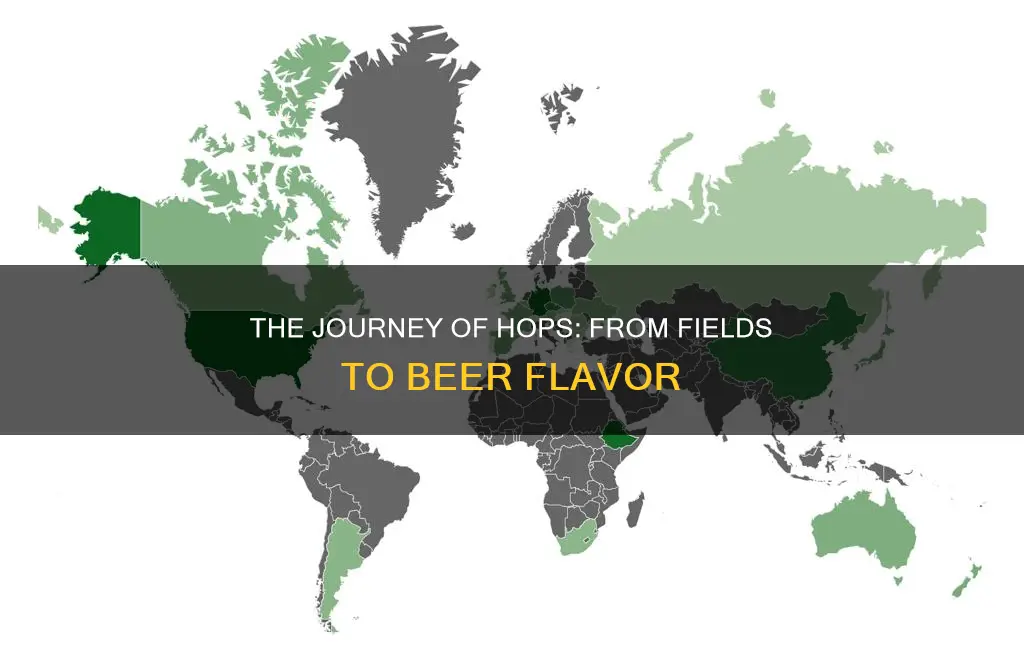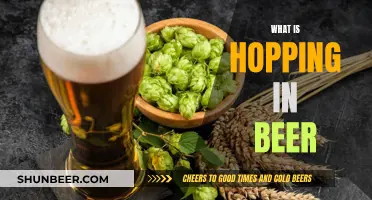
Hops are the flowers (also called seed cones or strobiles) of the hop plant Humulus lupulus. They are used primarily as a bittering, flavouring, and stability agent in beer. Hops are also used for various purposes in other beverages and herbal medicine. The first documented use of hops in beer is from the 9th century, though Hildegard of Bingen, 300 years later, is often cited as the earliest documented source. Hops are grown all over the world, with notable producers including Germany, the Czech Republic, New Zealand, and North America.
| Characteristics | Values |
|---|---|
| What are hops? | Cone-shaped flowers of the female hops plant, aka Humulus lupulus |
| Plant type | Climbing perennial |
| Source of bitterness, aroma, and flavor in beer | Tiny yellow pods or glands called lupulin inside hop cones |
| Notable hop producers | Germany, Czech Republic, New Zealand, North America |
| Top hop-producing states in North America | Oregon, Idaho, Washington |
| Ideal climate for hop growth | Moderate climate with rich soil and abundant sunshine |
| Hops varieties | Bittering, aroma, dual-use |
What You'll Learn

Hops are the flowers of the hop plant, Humulus lupulus
The hop plant is a vigorous, climbing, herbaceous perennial. It is usually trained to grow up strings in a field called a hopfield, hop garden, or hop yard when grown commercially. The hop plant has separate female and male plants, and only female plants are used for commercial production. The female plants are propagated vegetatively, and the male plants are culled if plants are grown from seeds.
The cones of the hop plant contain tiny yellow pods called lupulin, which contain resin and essential oils. These are the driving source of bitterness, aroma, and flavour in beers. The resins and oils inside the lupulin glands of the hop cones give hops their unique flavours and aromas.
Hops are added during the boil stage of brewing beer. It takes a long time (around an hour) to unleash the "alpha" acids that bitter and balance the sweetness of the malt. Hops can also be dry hopped (added to the fermenter) or fresh hopped (when just-picked hops are brought to the brewery). The timing of when hops are added during the brewing process will depend on the style of beer being made and the desired flavour profile.
Dry Hopping in Primary: A Guide for Beer Brewers
You may want to see also

Hops are used to flavour beer and are packed with oils
Hops are the flowers, or cones, of the Humulus lupulus plant. They are used to flavour beer and are packed with oils. Hops are divided into two very general varieties: bittering and aroma.
Bittering hops will have higher alpha acids, making them more economical for bittering beer (a small amount goes a long way). They are responsible for the bitter taste of beer (along with the alcohol). Bitterness is measured in International Bittering Units (IBU). A higher beer hop content leads to a longer shelf life.
Aroma hops will tend to have more essential oils. It is these highly volatile essential oils that contribute much of what people understand as "hoppiness". Aroma hops are the primary contributors of hop aroma and (non-bitter) flavour. They are often added after the wort has cooled and while the beer ferments, a technique known as "dry hopping", which contributes to the hop aroma.
The flavour of the hops comes from the unique blend of oils present in each unique variety. Hops can impart floral, fruity, or citrus flavours and aromas.
Hops are also used for various purposes in other beverages and herbal medicine.
The Magic of Hop Extract in Beer Explained
You may want to see also

Hops are divided into two varieties: bittering and aroma
Hops are the flowers (also called seed cones or strobiles) of the hop plant Humulus lupulus. They are used primarily as a bittering, flavouring, and stability agent in beer. Hops are divided into two very general varieties: bittering and aroma.
Bittering Hops
Bittering hops have higher concentrations of alpha acids, making them more economical for bittering beer. A small amount goes a long way. They are added at the start of the boil and are boiled for about an hour. Longer boil times result in the isomerization of more alpha acids, leading to increased bitterness. The bittering hops are boiled for longer, typically 60–90 minutes, and often have inferior aromatic properties, as the aromatic compounds evaporate during the boil.
Aroma Hops
Aroma hops tend to have more essential oils. It is these highly volatile essential oils that contribute much of what people understand as “hoppiness”. Aroma hops are also known as finishing hops, as they are added for their flavouring. They are boiled for a much shorter time, so more of their flavour and character are captured by the beer. Aroma hops are typically added to the wort later to prevent the evaporation of the essential oils. They are often added after the wort has cooled and while the beer ferments, a technique known as "dry hopping", which contributes to the hop aroma.
Dual-Purpose Hops
In addition to the two main varieties, many hops are now being classified as "Dual-Purpose", meaning they can be used for bittering or aroma. Dual-purpose hops have high amounts of both alpha acids and essential oils. They can be added at any part of the brewing process.
Hops in Beer: Understanding the Magic Numbers
You may want to see also

Hops are grown all over the world
Hops are the flowers (also called seed cones or strobiles) of the hop plant Humulus lupulus, a member of the Cannabaceae family of flowering plants. They are used as a bittering, flavouring, and stability agent in beer. Hops are grown all over the world, with notable producers including Germany, the Czech Republic, New Zealand, and North America. In the United States, Oregon, Idaho, and Washington are the top hop-producing states, with much of the production occurring in the Pacific Northwest.
The first documented hop cultivation was in 736 in the Hallertau region of present-day Germany, and hops continue to be grown in this region today. Other important production centres include the Žatec (Saaz) region in the Czech Republic, the Yakima Valley in Washington, the Willamette Valley in Oregon, and western Canyon County in Idaho. In the United Kingdom, the principal production centres are in Kent, Herefordshire, and Worcestershire.
Hops are typically grown in moderate climates with rich soil and abundant sunshine. These ideal regions generally sit at similar latitudes on the world map, both northern and southern. The plants are usually trained to grow up strings or wires that support their climbing habit and allow for greater growth.
Many different varieties of hops are grown by farmers around the world, with different types used for particular styles of beer. For example, European noble hops such as Saaz, Hallertau, and Strissel Spalt are often used in pale lagers, while British ales may use hops such as Fuggles, Goldings, and W.G.V. North American beers often feature hops such as Cascade, Columbus, and Centennial.
Icehouse Beer: Hops or No Hops?
You may want to see also

Hops are added to the boil stage of brewing beer
Hops are added to the boil to extract their alpha and beta acids, which add bitterness to balance the sweetness of the malt. The longer the hops are boiled, the more bittering qualities are extracted, while the aromatic oils tend to deplete. Therefore, the timing of hop additions during the boil is crucial in achieving the desired flavour profile.
Typically, hops are added during the bittering, flavour, and aroma stages of the boil. Bittering hops are added at the beginning of the boil and boiled for around 60 minutes to extract maximum bitterness. Flavouring hops are added with 15-30 minutes remaining in the boil to impart a crisp hoppy flavour without extracting too much bitterness. Aroma hops are added during the last 5-10 minutes of the boil or at flame-out to preserve their volatile aromatic oils, which provide the "hoppy" aroma.
The choice of hop variety and timing of additions will depend on the desired style and flavour profile of the beer. Some beers may have only one hop addition, while others may have up to 5 or 6 additions to create a more complex flavour profile.
Hops and Hormones: The Estrogen-Beer Link Explained
You may want to see also







